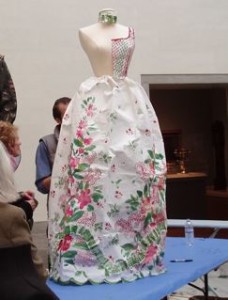Portraiture art has been our window to images of fabulous fabrics – and the clothing made from them – during the middle ages and through part of the twentieth century. Isabelle de Borchgrave transforms that two dimensional image of clothing to three dimensions, with the simple tools of paper and paint. Assembled with the inspiration and magic of Isabelle de Borchgrave, a celebrated Belgian artist and designer, the Pulp Fashion exhibit is a dazzling hologram of portraiture art, which can revitalize anyone’s perspective on how simple materials can make such a profound impact in our lives.
Jill D’Alessandro, curator, perfectly showcases de Borchgrave’s art. The costumes are so well placed, there is a recurring sense of being in the middle of a conversation with the women who would have worn these dresses. I consistently found myself double-taking what was fabric and what was the illusion of it. Real textile examples interspersed throughout the exhibit helped keep perspective.
Isabelle’s goal is not faithful reproduction, but to capture of the essence of the wearer of the garment. Her inspiration is channeled through portraits and the arts, as well as an intuitive sense of history. Her garments exude the illusion of the spirit of the wearer. It’s the trick that garners faithful attention in an exacting process that yields the final full scale fantasy.
Most of us in the fiber arts like to “have a hand” in what we do. We see something that resonates, and our challenge is to devise it with our own twist. Some strive to reproduce clothing to exact style, dimension and fabric, as was masterfully done with the Plimoth Jacket project (1). When our muse is based on oil, watercolor and canvas, how do we capture the essence of clothing from a portrait that arrests the soul to a 3D translation? How can we express the wonder of what the subject was thinking, how they felt in the clothes they wore? Most importantly, how can that feeling be translated so it communicates to the observer? Trompe L’Oeil challenges the observer’s ability to discern reality from fiction. And so de Borchgrave harnesses paper and paint, in a Trompe L’Oeil medium, to trick the eye and bring portrait clothing to life.

Isabelle de Borchgrave and studio collaborators at work on a piece inspired by Agnolo Bronzino's portrait of Eleanor of Toledo, 2006. Photo: Courtesy Creations Isabelle Borchgrave
There are five sections of the exhibit – In White, Papiers a la Mode, Fortuny, The Medici, and Inspirations. Especially dramatic is the Fortuny tent. The original tent was exhibited at the 1911 Exposition des Arts Decoratifs in Paris. Isabelle wanted to re-create that environment to give Fortuny’s work his due.

Delphos Dress and Coat Isabel de Borchgrave 2006-2007 Inspired by Fortuny design photo: Rene Stoeltie
And indeed she did. Standing under the canopy and absorbing all the detail of the chandeliers, desk, and incredible Delphos dress and tunic based on a Man Ray photo, is one step away from the sensation of being transported to that time and place. A nearby closet is full of paper clothes and accessories – right down to shoes and boxes!
Real fabrics are set on walls or in free standing cases to keep the mind grounded while touring the exhibit. There are some gems, too, for the “fabriphile” in all of us. A length of 17th century velvet is a salute to the velvet and silk guilds that the Medici bankrolled. There is a 1742-dated length of silk and metallic thread fabric from the Fine Arts Museum of San Francisco textile collection. Other points of reference include a Jacobean embroidered forehead cloth (Fine Arts Museum of San Francisco collection) and actual lace flounces from real linen needle lace in the “reticella & punt in aria” technique. 15th and 16th century lace collars signal a solid point of reference to the authenticity of de Borcgrave’s expertise in her paper lace collars.

Isabelle Borchgrave. Marie de'Medici (detail)lace collar. Inspired by 1595 portrait by Pietro Facchetti. Photo: Andreas von Einsiedel
The Resurrection, a tapestry from the Redemption of Man series (1510-1525) made from wool, silk, in tapestry weave serves as another reminder of one art muse waiting for translation to paper life.
I was fortunate enough to attend when the exhibit first opened, and witnessed Isabelle and her assistants demonstrating her technique live – and it was like watching magic unfold. Her hand is quick and competent. She described her movements as she created a flower pattern and cut and shaped the paper from bolt to garment, as you would create a dress by folding, cutting and sewing fabric. “Use any tool you want – hand, brushes, stencils” she remarked as she painted the flower pattern, and her assistant stood at the ready with a hand-held blow dryer. Her creations are worked on bolts of high rag paper primed with white paint. It is surprisingly soft to the touch, and very pliable. You can watch Isabelle and her assistants in action in the exhibit video – The Artist’s Studio – near the entrance. Note that Isabelle is shown trying one of her creations for fit and dimension.

The artist at work at the exhibit demonstration. Photo courtesy of the author

The demonstration piece coming together. Photo courtesy of the author
The In White section of the exhibit has a myriad of techniques that belie their deceptive colorway simplicity. The American Day Suit and Hat is based on a circa 1900 cotton pinstripe, where each line was painted by hand. Isabelle has stated that she has found the simpler the fabric, the more difficult it is to reproduce.
My favorite costume was in the Medici section – Isabella de Medici interpreted from a 1565 portrait by Alessandro Allori in Florence’s Palazzo Pitti. The detail is arresting – a handkerchief with lace edging; pearl strings; ruffled and pearled head wrap. Another favorite of mine (I found that it’s impossible to have just one) was Marie de Medici, who appears in two interpretations, both exquisite in their detail – the adjustment of lace, book and gloves in hand. I found myself talking to them!
Proof that de Borchgrave does not stand on her past accomplishments, the Neapolitan Woman, based on Massimo Stanzione’s 1635 portrait, was created just for this exhibit. The portrait is on display in the Legion, situated close enough to compare muse and rendition, right down to the fully conceived rooster in arm! Don’t forget to note the ruffled edges on the vertical stripe of the skirt fabric.
In the end, it is astounding to realize this is all paper. It would be impossible to create all this goodness without cutting and shaping the images and patterns. Now there is something to think about with your next weaving project. Trust in the magic!
The exhibit is open through June 6, 2011. For information on hours and location, visit http://legionofhonor.famsf.org/legion/exhibitions/pulp-fashion-art-isabelle-de-borchgrave
Sources and References:
Footnote:
(1) Plimoth Jacket
http://www.winterthur.org/pdfs/Plimoth-Jacket.pdf
http://www.plimoth.org/embroidery-blog/
More about Isabella:
http://www.isabelledeborchgrave.com/en_home.php
the deYoung information:
http://legionofhonor.famsf.org/legion/exhibitions/pulp-fashion-art-isabelle-de-borchgrave
Exhibit Books available:
“Pulp Fashion the art of Isabelle de Borchgrave” http://shop.famsf.org/do/product/978-3791351056
“Paper Illusions: the Art of Isabelle de Borchgrave”
http://shop.famsf.org/do/product/BooksAndMediaTextilesAndCostume/978-0810971332
For the next article, Click here
